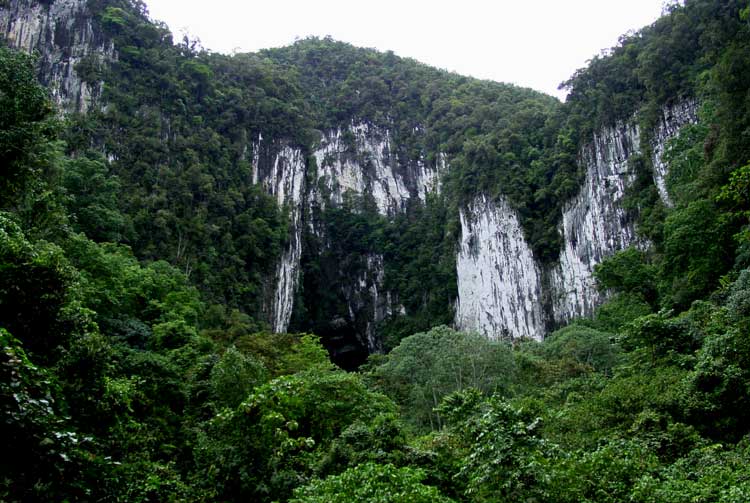Deer Cave / Mulu National Park

It's not called the bat cave, but it's home to 3 million to 4 million bats of several species, and about 6 p.m. they all fly out for their nightly hunting. Mulu is delightfully free of mosquitos, and people say the bats are to be thanked for that. My video camera was having a dampness attack (from which it later recovered) and the zoom on my still camera just wasn't adequate to capture the bats.
They came out first in small clouds, like puffs of smoke made up of whirling black specks. Their individual movement appeared erratic, but as a pack they moved in concert, flying over our heads and out of sight behind the trees. They kept coming until we could no longer see any separation between the groups, and now the column of bats moved like chimney smoke on a day with just a little wind, snaking left and right but not breaking. They did not spread out across the sky but clustered together in a band, and they kept coming for an extraordinarily long time, until it became easy to belive there are 4 million of them.
It's more than a 3 km walk along a wide boardwalk through rainforest from the park headquarters to Lang's Cave and the Deer Cave (so called because local people used to corner deer there and kill them for meat). Lang's Cave has beautiful limestone formations (but my video was out of whack). The Deer Cave is impressive for its immense size and the slime of bat guano throughout -- but we were very lucky. It had been raining lightly, and that decreased the smell considerably. Matthew said some days the ammonia is so strong, it makes his eyes tear. We were doubly lucky because the bats do not fly out if it's raining, but the rain quit falling soon after we left the cave.
At the end of the Deer Cave, you're treated to a view of the outside world that they call the Garden of Eden (below).
In the morning we flew back to Miri and then on to Kuching. From there we traveled by van and by longboat to an Iban longhouse.
